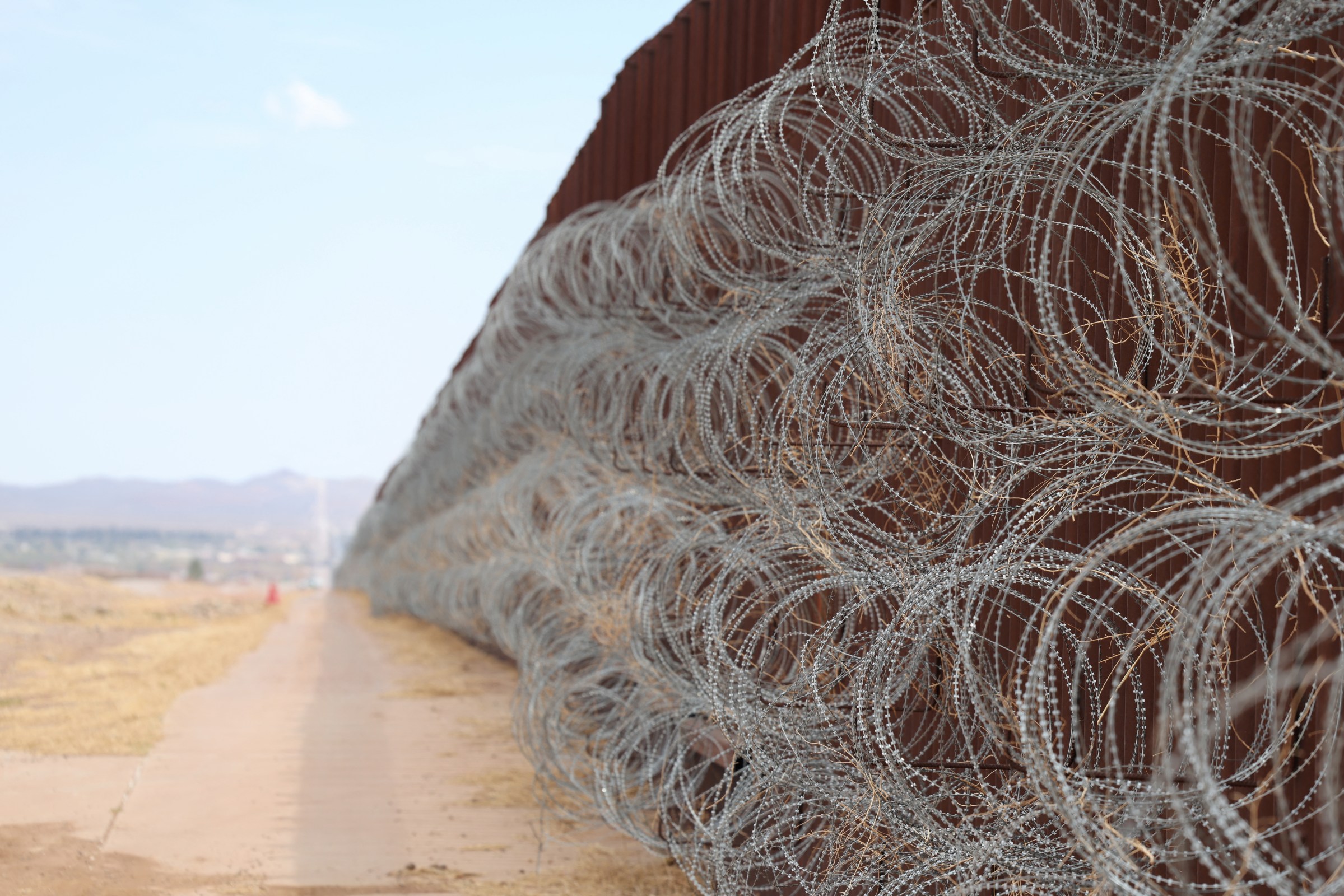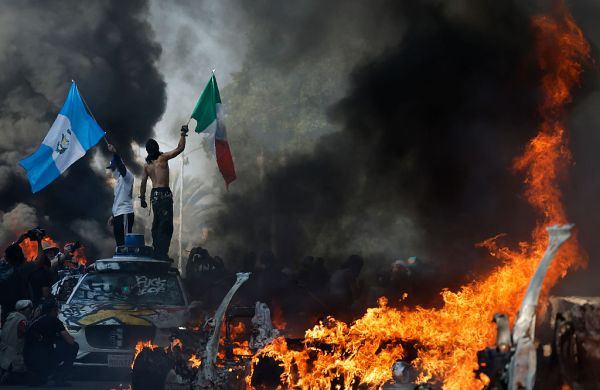During a 2021 trip to Central America, then-Vice President Kamala Harris directed a blunt message to migrants: “Do not come.” Aiming to discourage illegal migration from the region, she stressed, “I believe if you come to our border, you will be turned back.”
But millions of migrants would cross the border in the following years of the Biden administration, overwhelming border authorities and eventually, major cities across the country. When Harris replaced former President Joe Biden atop the Democratic ticket, Republicans homed in on her immigration policy record, and the flood of illegal migration across the border became even more central to President Donald Trump’s 2024 campaign, second only to the economy in importance among Trump supporters.
Four months into the new administration, the number of people encountered by Customs and Border Patrol (CBP) after crossing the southern border illegally has plummeted. The numbers had already begun trending downward toward the tail end of Biden’s presidency, with CBP encountering just 47,000 people at the southern border in December and 29,000 in January, far below the December 2023 peak of nearly 250,000. But that reduced flow has become a trickle in the last four months: CBP intercepted approximately 8,300 migrants along the U.S.-Mexico border in February, 7,100 in March, 8,300 in April, and 8,700 in May.
If illegal crossings stay in this range, the southern border will be the quietest it’s been in more than a half-century.
The president and senior officials have wasted no time taking a victory lap, declaring in April that CBP now has “total control” over the most secure border in U.S. history. “President Trump was able to accomplish that in seven weeks,” said border czar Tom Homan in April. “That’s something that Joe Biden didn’t, wouldn’t do in four years.” Controlling the border wasn’t really about a complex mix of economic, humanitarian, and regional governance factors; it was simply a matter of political will, so the administration argues.
Supporters of Trump’s border policies have excoriated Biden and Harris for arguing the crisis at the border was the result of a broken immigration system and root causes largely outside of U.S. control. “Everything the Democrats told America about the expensive, time-consuming complexity necessary to fix a ‘broken immigration system’ stands exposed as propaganda devoid of even the smallest nugget of truth,” argued Todd Bensman, a former senior national security fellow at the Center for Immigration Studies who joined the administration this month as a senior adviser to Homan, in an April op-ed.
What’s changed under Trump? Since taking office, the president has declared a national emergency over the “invasion” of migrants and deployed more than 10,000 U.S. military and National Guard personnel to assist in “sealing” the southern border. In a separate proclamation, Trump effectively suspended entry along the southern border and blocked migrants “from invoking provisions of the [Immigration and Nationality Act] that would permit their continued presence in the United States” for the duration of the “invasion.” The suspended protections include claiming asylum—the route that hundreds of thousands of illegal migrants have used to avoid deportation in recent years.
The president also suspended the “catch-and-release” policy of allowing migrants assessed as posing no security or flight risks to remain in the country until their cases are heard, and he directed the Department of Homeland Security (DHS) to reinstate “remain in Mexico”—a policy that returns some migrants who have crossed the border illegally to Mexico while their removal proceedings are ongoing. The administration shut down the CBP One app, a Biden administration initiative intended to incentivize asylum seekers to schedule an appointment at a port of entry rather than cross the border illegally. The administration also moved to end humanitarian parole and programs allowing migrants from specific countries to secure temporary protected status—the latter protected migrants from more than a dozen countries fleeing violence and instability, including people from Afghanistan and Ukraine.
In short, the legal pathways and humanitarian protections enabling migrants to remain in the U.S. have closed almost entirely. “There’s no access to asylum, there’s very limited access to humanitarian protection,” Colleen Putzel-Kavanaugh, a policy analyst at the Migration Policy Institute, told The Dispatch. “There’s higher chances of being deported immediately from the border or being transferred to ICE custody. It’s very unlikely that someone who crosses the border now would ultimately be released from custody into the U.S. because of those policies.”
Immigration analysts and former officials The Dispatch spoke with emphasized that making asylum inaccessible is likely one of the most significant factors in reducing the number of border crossings. “[Trump] has adopted an extreme policy of essentially total exclusion, a total ban on asylum, and that has led to fewer people attempting the journey,” said David Bier, the director of immigration studies at the Cato Institute.
Those attempts began slowing after Biden implemented a new rule in June 2024 that restricted access to asylum for migrants crossing the border illegally between ports of entry and directed people to instead make appointments through the CBP one app. The Trump administration is “trying to add deterrence to the mix, trying to deter people from crossing, but it’s the cutting off of the access of the asylum system that is really driving the decline in numbers,” said John Sandweg, a former acting director of Immigration and Customs Enforcement (ICE) during the Obama administration.
Overall, Biden took a less stringent enforcement approach, particularly during the first half of his administration. “Reducing the number of people attempting to cross illegally through not only the strong messaging, but the fact that people would be held and repatriated; the fact that they were able to get the Venezuelans to accept repatriation; these are all things that could have, should have been done, and the Biden administration didn’t do it,” Gil Kerlikowske, the CBP commissioner during the Obama administration, told The Dispatch.
The Trump administration has pursued an aggressive, legally questionable, and much publicized interior deportation program, including removing several hundred migrants to a massive prison in El Salvador. DHS has ramped up enforcement measures including significantly expanding expedited removals—a process by which ICE and CBP agents can quickly deport migrants without going before an immigration court judge. The expedited removal process was previously used only against migrants within 100 miles of the border who had been in the country for two weeks or less. DHS is now applying expedited removal to any illegal immigrant in the country who can’t prove they’ve been a resident for more than two years. These efforts have had a further chilling effect on people considering making the journey to the U.S., Putzel-Kavanuagh and Bier said.
Immigration has also been at the forefront of the administration’s foreign policy towards regional countries that migrants travel through before reaching the border. The president has leaned on Mexico and Panama in particular, using the threat of tariffs, or in the case of Panama, seizing its canal, to push for increased immigration enforcement, among other foreign policy priorities.
“People are still leaving largely South American countries; they’re just not getting past critical choke points,” Gil Guerra, an immigration policy analyst at the Niskanen Center told The Dispatch, citing Panama’s border enforcement at the Darién Gap—the land bridge between Panama and Colombia connecting Central and South America—and Mexico’s enforcement measures throughout the country and near the U.S. border.
The Biden administration had previously secured agreements with Panama and Mexico on enforcement and deportations. But Guerra argued that both countries’ continued efforts can at least partly be attributed to pressure from the Trump administration. “We weren’t talking about seizing the Panama Canal under Biden, and we weren’t talking about unilateral military strikes on cartel targets under Biden,” Guerra said. “[Panama and Mexico] both have really strong incentives based on just how tumultuous other aspects of the bilateral relationship with the U.S. are to actually put a lot of effort into curbing those migration numbers.”
But despite the new enforcement regime and hardline diplomacy, the analysts and former officials The Dispatch spoke with said the historically low levels of the last four months could ultimately prove less enduring than the president and his allies let on.
A similar dip occurred during the initial months of the first Trump administration, although not to levels quite so low. “My administration is—just a matter of weeks, literally, a short period of time—has brought record reductions to illegal immigration,” Trump said in April 2017. “Record reductions. Down 61 percent since inauguration.” There were just over 12,000 encounters in March 2017. But migration levels soon began to tick up again and spiked to more than 130,000 encounters in May 2019.
If the two biggest factors influencing the decline are the enforcement efforts of countries like Mexico and Panama and the suspension of asylum, neither are solely within the president’s control. Trump may be able to push countries to step up enforcement for now, but it remains to be seen how lasting such an “all-stick, no carrot” approach proves to be. The testy relationship between the Trump administration and Panamanian President José Raúl Mulino over the Panama Canal and U.S. security cooperation has only added pressure to a tense domestic political environment.
Putzel-Kavanaugh said current U.S. diplomacy contrasts with Biden’s work “fostering a dialogue amongst various countries” in the region. She emphasized that much of the downward trend in illegal crossings are the result of increased immigration enforcement within Mexico that the Biden administration negotiated following the peak in crossings in December 2023, and it’s uncertain how long cooperation on migration management will last under the Trump administration’s strong-arming approach.
The asylum shutoff also faces legal challenges—as do nearly all of the administration’s border enforcement and immigration policies—that could restore asylum access and potentially drive more migrants to make the journey to the border. Court decisions are still pending on the challenges, but the less trafficked the border is, the less credible the administration’s claims of an “invasion” become. “The Invasion of our Country is OVER,” Trump posted on TruthSocial in March after the February numbers were released.
Even if the asylum route remains closed indefinitely, Sandweg argued, we could see a reversion to crossing strategies where people try to evade apprehension rather than surrendering themselves to Border Patrol agents and making an asylum claim. “I would expect us to see a return to something similar to what we saw prior to 2014 [and 2015], which is people coming across the border trying to avoid the detection of the Border Patrol,” Sandweg said. He also said that the record high levels of migration in recent years may have temporarily exhausted the population of people willing and able to risk the journey.
“I would anticipate the numbers will probably be lower for some time, because the potential people willing to go through that in order to come to the United States, a lot of them have come,” Sandweg said, but he added, “I think it would just be naive to anticipate that we’ve now entered a long-term era of low border apprehension numbers.”
Military officials with operational responsibility over the southern border suggest that more time is needed to see if the administration’s enforcement policies stand the test of evolving migration patterns. “The initial results of sealing the border have been fantastic if you look at the stats,” Gen. Gregory Guillot, the head of U.S. Northern Command, told the House Armed Services Committee in April. “But we need to make sure, one, that that’s lasting and goes through all the cycles of illegal migration that we see.”
Bier argued that maintaining a deterrent effect could encounter a threshold problem. It’s feasible for the administration to detain and deport all illegal migrants when the numbers are low enough, thereby sending a signal to other migrants that their chances of being released into the U.S. are low and further discouraging illegal crossings. But a new wave of migration could also start a negative enforcement spiral. “If you impose harsh enough punishment that certainly can have an effect; you start sending people to your gulag, people are gonna think twice about crossing the border,” Bier said. “It’s just that when you have large enough flows, it’s really hard to maintain that level of enforcement, and so it only really requires a crack in whatever enforcement regime is imposed to create an opportunity for the whole system to come apart.”
Officials trumpeted the release of May’s encounter numbers this week, highlighting that the Border Patrol released zero illegal immigrants during the month in contrast to the 62,000 released last May. “The Trump administration’s goal right now seems to be to have low numbers and be able to claim that victory,” said Putzel-Kavanuagh. “By taking away protection and doubling down on enforcement, they may have found the formula that does that. Time will tell.”










Please note that we at The Dispatch hold ourselves, our work, and our commenters to a higher standard than other places on the internet. We welcome comments that foster genuine debate or discussion—including comments critical of us or our work—but responses that include ad hominem attacks on fellow Dispatch members or are intended to stoke fear and anger may be moderated.
With your membership, you only have the ability to comment on The Morning Dispatch articles. Consider upgrading to join the conversation everywhere.